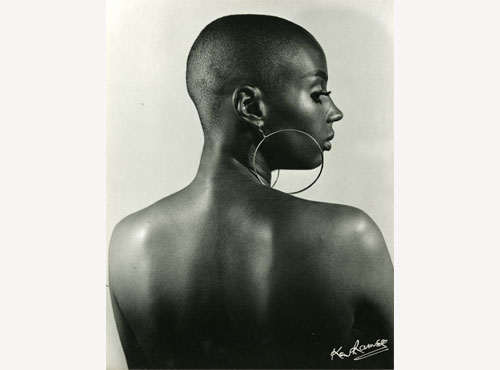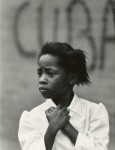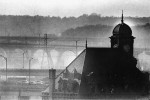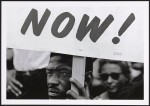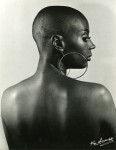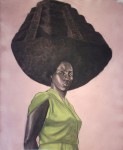Starting in January 2014, eight Richmond-based arts and cultural organizations will partner to facilitate community-wide conversations inspired by their respective exhibitions and programs. Participating institutions include Candela Books + Gallery, Anderson Gallery VCUarts, Black Iris, 1708 Gallery, Elegba Folklore Society, Reynolds Gallery, the Valentine Richmond History Center, and the Virginia Museum of Fine Arts. Many of the programs and exhibitions will occur in January and February, with additional offerings to follow in the spring.
Events are free and open to the public, except where otherwise noted. Click on the link for each venue’s website for directions, gallery hours, and other details.
2014 Community Conversations Series
Organized by Valentine Richmond History Center
The Valentine Richmond History Center collaborates with Richmond Magazine to present the Community Conversations series, conceived to engage the community in a dialogue about the region’s past and how that past can positively shape our collective future. Featured are five monthly discussions about various Richmond localities, from Shockoe Bottom to the Boulevard. A Richmond Magazine moderator will lead each discussion, illuminating historical and current-day perspectives that shape our understanding and experience of each location. As with any topic about Richmond’s history, race, place and identity are formative subtexts.
Shockoe Bottom’s Future with Chris Dovi
Tuesday, January 7, 6-8 pm
Arcadia (upper room), 1700 E Main St
Monroe Park with Harry Kollatz, Jr.
Tuesday, February 4, 6-8 pm
The Nile, 309 N Laurel St
Riverfront Development with Jack Cooksey
Tuesday, March 4, 6-8 pm
F.W. Sullivan’s Canal Bar & Grill (Richmond Room), 1001 Haxall Point
Transportation on Broad Street with Susan Winiecki
Tuesday, April 1, 6-8 pm
Mama J’s Kitchen, 415 N 1st St
Up and Down the Boulevard with Tina Eshleman
Thursday, May 1, 6-8 pm
Virginia Museum of Fine Arts, Claiborne Robertson Room & Best Café
Body as Art: Photographs by Thierry Laurence
Through January 31
Elegba Folklore Society’s Cultural Center
In this series of black-and-white photographs, Thierry Laurence manipulates light, shadow, and water to express an artistic essence of the black male body. In his provocative portraits, Laurence reinforces abstraction elements that refer to the humanity and body politics of African American men in the 21st century. “When I have a camera in hand,” he says, “I want to capture the moments where shadows give way to light and allow us to see.”
The exhibition combines Laurence’s portraits with photographs from another series, WET: An Exploration of Water and Light. Both groups of works feature impressionistic imagery with highlights created digitally and inspired externally (people watching) or internally (soul searching), ensuring a flexibility that allows Laurence to continually push his image-making. He notes, “We can only see into the darkness with light, but sometimes our view is still distorted or reveals only a portion of the whole.”
At the Crossroads: Black Males + Race, Place, & Identity with Instructor Derrick Lanois, VCU Department of African American Studies
Monday, January 20, 6 p.m.
Elegba Folklore Society’s Cultural Center
Louis Draper Retrospective
January 10–February 22
Candela Books + Gallery
Candela Books + Gallery hosts the first-ever retrospective of mid-century African-American photographer Louis Draper (1935-2002). The exhibition will showcase over 40 photographs spanning Draper’s career, from the late 1950s to 1990s. Although he was primarily a street photographer, his archive encompasses a wide range of artistic approaches and subjects, including portraiture and abstraction.
A native of Richmond, Virginia, Draper moved to Harlem to study photography in 1958, a time of growing civil unrest across the country. There he was a founding member of the Kamoinge Workshop, the seminal black photographers’ collective whose intention was “to create the kind of images of our communities that spoke the truth we’d witnessed and that countered the untruths we’d all seen in mainline publications.” Notable contemporaries photographed by Draper include Langston Hughes, Hughie Lee Smith, Miles Davis, Malcolm X, Katherine Dunham, and the civil rights activist, Fannie Lou Hamer.
Opening Reception
Friday, January 10, 5-8 p.m.
Candela Books + Gallery
Signs of Protest: Photographs from the Civil Rights Era
January 11 – August 3
Virginia Museum of Fine Arts
Signs and protests were inseparable in the 1960s and produced maximum impact when photographed or filmed by the media. This exhibition includes 25 photographs of the culture of resistance during that turbulent decade, with an emphasis on civil rights leaders Martin Luther King Jr., Malcolm X, and Stokely Carmichael. In addition to Benedict Fernandez’s powerful portfolio Countdown to Eternity, which documents the last year of King’s life, other works by Gordon Parks, Danny Lyon, Bob Adelman, Leroy Henderson, Louis Draper, Alf Kumalo, and Ian Berry provide powerful reminders of the segregated “Jim Crow” South and momentous events like the 1963 March on Washington.
The photographs also follow the evolution of protest from civil rights and black power to Vietnam War demonstrations and, in subsequent decades, rallies fighting South African apartheid. Signs of Protest is curated by Dr. Sarah Eckhardt, Assistant Curator of Modern and Contemporary Art.
Conversations: Signs of Protest with Associate Professor John Edward Mason, UVA Corcoran Department of History
Thursday, January 23, 6 p.m.
VMFA, Claiborne Robertson Room
African American Read-In Day
Thursday, February 20, 5 p.m.
VMFA, meet at Visitor Services Desk.
As part of a national event, VMFA staff and members of the community share African American literature through readings, poetry, and speeches.
King: A Filmed Record . . . Montgomery to Memphis
1970, directed by Sidney Lumet and Joseph Mankiewicz
Friday, February 21, 6:30 p.m. (185 min.)
VMFA, Leslie Cheek Theater
Admission: $8 (VMFA members $5)
LaToya Ruby Frazier: A Haunted Capital
January 17–March 9
Anderson Gallery VCUarts
Informed by an intensely personal and socially activist stance that combines elements of portraiture and social documentary, LaToya Ruby Frazier’s photographs and videos portray her family and her hometown of Braddock, Pennsylvania, the site of Andrew Carnegie’s first steel mill. As Frazier focuses her lens on her grandmother, her mother, and herself, collaboratively addressing issues of self-representation, she illuminates how the histories of individuals and communities intertwine.
Each generation of her family represents a different period in Braddock’s evolution, from its early twentieth-century prosperity to its dramatic decline in the wake of deindustrialization and governmental abandonment. Braddock’s few remaining inhabitants, many of them African American, now struggle economically with little access to health care. Though intimate in scope, Frazier’s images powerfully draw attention to larger social issues pertaining to class and the environment. LaToya Ruby Frazier: A Haunted Capital was organized by the Brooklyn Museum.
In Conversation: LaToya Ruby Frazier with Curator Dean Daderko, Contemporary Arts Museum, Houston, and Curatorial Associate Anna Stothart, ICA, Boston
Thursday, January 16, 5:30 p.m.
Grace Street Theater, 934 W Grace St
Cosponsored by VCUarts Department of Photography & Film
Opening Reception
Friday, January 17, 5-7 p.m.
Anderson Gallery
Public Eye: Civil Rights Case Study
January 17–February 28
Black Iris Gallery
This exhibition of over 400 photographs, films, and artifacts from a veiled archive examines the extent to which the rise of the modern Civil Rights Movement has impacted our understanding of the power of image.
Public Eye: A Civil Rights Case Study examines the daily happenings and monumental moments of the historic Civil Rights era. On display are documents of the organizing and shaping of the transformative fight for racial equality and justice in the United States from the 1960s to the 1970s, as captured by the unblinking eye of surveillance. This visual document of the socio-political landscape of Richmond captures the daily activities and public protests of the many struggles that defined the era. The role played by surveillance culture in the struggle for social justice frames changing and prevailing ideas about race, justice, and freedom in America.
Opening Reception
Friday, January 17, 6 p.m.
Black Iris Gallery
Book Reading with Bill Ayers
Public Enemy: Confessions of an American Dissident
Date: TBA
African Root, American Fruit: Paintings by Ronald Jackson
February 7–April 30
Elegba Folklore Society’s Cultural Center
Ronald Jackson paints portraits and figurative works to comment on the identity of African American people and their influence on the landscape of American society. His work shifts from a painterly approach, to the message-centric rendering of illustration, to the expressive simplicity of folk art. In all instances, he seeks to evoke a sensibility, a mood, or an emotion, suggesting a narrative of place, thought, and reflection. “I am driven by the legacy that art can give to a culture, Jackson says. “ I want my art to become a catalyst to trigger the self-discovery of value, beauty, and significance among people of color.”
Culture, Art and Social Messaging: Gallery Talk with Ronald Jackson
Friday, February 7, 6 p.m.
Elegba Folklore Society’s Cultural Center
Hair Craft Project
February 14–March 8
1708 Gallery
Hairdressing is the earliest manipulation of fiber toward an aesthetic and functional purpose. For The Hair Craft Project, artist Sonya Clark engaged a group of local hairstylists who first braid Clark’s hair, demonstrating their signature styles. The finished styles and the stylists are documented by Richmond photographer Naoko Wowsugi. The stylists are then given a canvas that has been hand-stitched with threads to simulate hair. Each stylist braids one of the stitched canvases, expanding their practices and extending their aesthetics into a non-functional role. The finished canvases will be exhibited alongside the documentation.
The Hair Craft Project aims to break down barriers by crossing boundaries between hair salons and art galleries as sites of aesthetics, craft, skill, improvisation, and commerce. It is organized by Sonya Clark, Chair of the VCUarts Department of Craft/Material Studies.
Sonya Clark at Reynolds Gallery
Opening Friday, February 21
A concurrent solo show will feature Sonya Clark’s sculptural works, which incorporate multiple materials and methods of making that reflect her background in the fiber arts and address themes of identity and heritage. In certain works, Clark augments found, sometimes historically loaded images and objects with multiple cornrows of braided and knotted black thread that blanket and dangle from their surfaces. By stitching these signifying elements onto her chosen artifacts, she layers an alternate, overtly political narrative that speaks of perseverance and continuity.
Upcoming at Virginia Museum of Fine Arts
Posing Beauty in African American Culture
April 27–July 26
This exhibition examines the contested ways in which African and African American beauty has been represented in historical and contemporary contexts through a diverse range of media, including photography, film, video, fashion, advertising, and other forms of popular culture such as music and the Internet. Drawn from both public and private collections, Posing Beauty features approximately 85 works by artists such as Carrie Mae Weems, Charles “Teenie” Harris, Eve Arnold, Gary Winogrand, Sheila Pree Bright, Leonard Freed, Renee Cox, Anthony Barboza, Bruce Davidson, Mickalene Thomas, and Jeanne Moutoussamy-Ashe. Organized by the Department of Photography & Imaging at New York University, Tisch School of the Arts, and curated by Deborah Willis.
Identity Shifts: Works from VMFA
April 27–July 26
In conjunction with Posing Beauty, this collection-based exhibition features works by African American artists who use representations of the human figure or some aspect of the body (including hair) to explore how we construct and perceive personal and cultural identity. The selection of paintings and sculptures, from the 1970s to the present, features an array of perspectives and styles that underscore the complex factors informing conceptions of race and gender, and includes works by such artists as Trenton Doyle Hancock, Robert Pruitt and iona rozeal brown. Many of these pieces will be on view at VMFA for the first time.
Reframing “Black is Beautiful” with Deborah Willis, Professor and Chair, Photography & Imaging, Tisch School of the Arts, New York University
Sunday, April 27, 3 p.m.
VMFA, Leslie Cheek Theater
Admission: $8 (VMFA members $5)
###
Contacts
Suzanne Hall, Chief Communications Officer, Virginia Museum of Fine Arts
suzanne.hall@vmfa.museum, 804-204-2704
Gordon Stettinius, Director, Candela Books + Gallery
elgordo@candelabooks.com, 804-255-5527
Traci Garland, Gallery Coordinator, Anderson Gallery VCUarts
thgarland@vcu.edu, 804-828-1524
Janine Y. Bell, President & Artistic Director, Elegba Folklore Society
jaybee@efsinc.org, 804-644-3900
Emily Smith, Director, 1708 Gallery
esmith@1708gallery.org, 804-643-1708
Benjamin Thorp, Black Iris
benjamin@blackiris.tv
Domenick Casuccio, Director of Public Relations & Marketing, Valentine Richmond History Center
dcasuccio@richmondhistorycenter.com, 804-649-0711
Beverly Reynolds, Director, Reynolds Gallery
breynoldsg@aol.com, 804-355-6553
